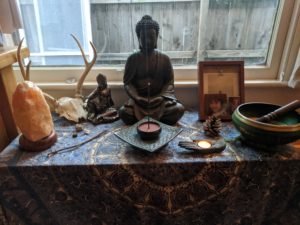Co-creating our online Zendo: sharing our home altars, by AZC Tanto Choro Antonaccio - UPDATED
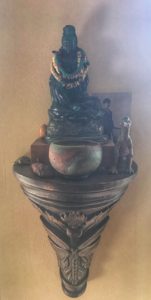 I had quite an elaborate home altar in my former abode in North Carolina. The house I lived in had a built-in shelf of three levels and so I had room to be expansive. I had pictures of deceased relatives and friends and teachers; large-ish statues of Shakyamuni Buddha and Kannon, and small figures of Manjushri and various other Buddhist embodiments. There was Calligraphy. Malas. A candle, incensor, flowers. And a lot of objects: stones, shells, a silver rattle from my babyhood with my name engraved on it that surfaced after my father died. When it came time to disassemble the whole thing as I was packing up to move to Austin, I couldn’t quite remember everything’s origin, but I knew they had been talismans for me at some point: everything had some association with a person, place, event, or inspiration.
I had quite an elaborate home altar in my former abode in North Carolina. The house I lived in had a built-in shelf of three levels and so I had room to be expansive. I had pictures of deceased relatives and friends and teachers; large-ish statues of Shakyamuni Buddha and Kannon, and small figures of Manjushri and various other Buddhist embodiments. There was Calligraphy. Malas. A candle, incensor, flowers. And a lot of objects: stones, shells, a silver rattle from my babyhood with my name engraved on it that surfaced after my father died. When it came time to disassemble the whole thing as I was packing up to move to Austin, I couldn’t quite remember everything’s origin, but I knew they had been talismans for me at some point: everything had some association with a person, place, event, or inspiration.
Recently, during the COVID-19 pandemic a zen temple in North Carolina called on 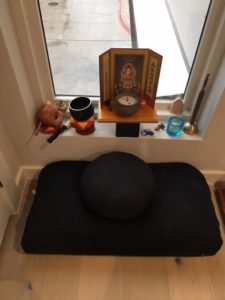 its members and friends to post pictures of their home altars since the sangha wasn’t able to physically gather to sit together. I thought this was something we might do as well. We have already shared our feline companions after morning zazen, and some of us show their surroundings while ‘Zooming Zazen’. So this is an invitation to share your altar, your sitting place, and we can all contribute to building and maintaining our shared practice.
its members and friends to post pictures of their home altars since the sangha wasn’t able to physically gather to sit together. I thought this was something we might do as well. We have already shared our feline companions after morning zazen, and some of us show their surroundings while ‘Zooming Zazen’. So this is an invitation to share your altar, your sitting place, and we can all contribute to building and maintaining our shared practice.
Here is my current, simplified altar: a traveling, folding altar I got in Tokyo at Soto Zen Headquarters; an incensor (rather too large) made by a Zen priest friend who is also a master potter; a portable inkin, and small mokugyo and bell; and a few figures (Jizo, Daruma) and token objects which will rotate. This is where I sit with you in the mornings at home. I would love to see yours!
With a deep bow,
Choro
AZC Tanto (Head of Practice)
Here are photos & words (as well as an offer!) from AZC Sangha members:
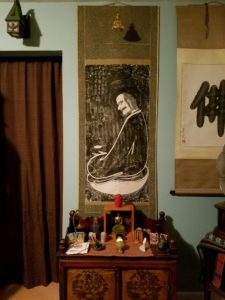
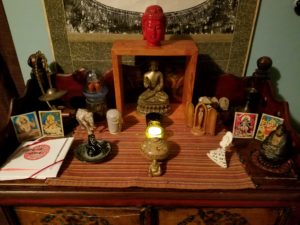 Mark B on the Bodhidharma scroll above his home altar:
Mark B on the Bodhidharma scroll above his home altar:
“It’s a rubbing on paper of a stele, which is a carved stone slab. It’s one of the two oldest representations of Bodhidharma, from the Stele Forest (Bei Lin) in Xi’an, China. In ancient times they would preserve calligraphy and artwork by carving it in stone. People would then make rubbings of it, kind of an ancient Chinese Xerox machine.”
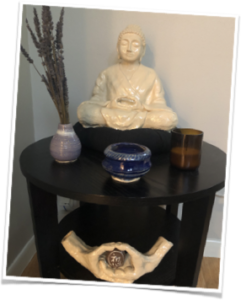 Nick S’s Home Altar:
Nick S’s Home Altar:
“Here is a picture of my home altar. This table is just the right height so when I sit Zazen in front of the altar, my hands are level with the sculpture of the hands.
That got me thinking that all of ‘my Sangha’ is at home practicing, and this might be a great time for them to make a little altar at home. So tell me what you need: Candles, a vase, an incensor, a Buddha sculpture?” Read more about Nick’s practice with Sculpting, and take him up on his offer to sculpt a Buddha or Bodhisattva for your own home altar
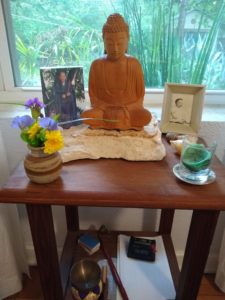 Kathy G’s Home Altar:
Kathy G’s Home Altar:
“I’ve had my home altar for many years. The table is from a thrift store. The Buddha came from Thailand, bought from a young man who had been there. Kosho suggested a photo of myself as a baby as a way to practice loving kindness. I went to a landscaping yard and was looking for just the right piece of limestone. When the owner asked what I was doing I told him I was looking for a stone for an altar. He gave it to me. The seashell is from India given to me by my father. One of the small stones is from Plum Village.”
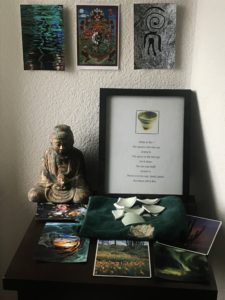 Bill H’s Home Altar:
Bill H’s Home Altar: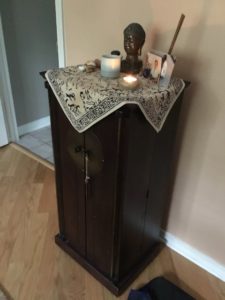 Pat Y’s Home Altar:
Pat Y’s Home Altar:
“This is my altar. It has a candle, a cup for holding incense with ash from my fireplace, incense, Buddha, some seashells (which are great for holding spent matches), and pictures of deceased family members (parents and brother). I bought the ‘altar’ at World Market. It is actually a CD holder. Someone joked that since it is an altar it would be only appropriate to hold spiritual CDs so I have great zen master Beethoven and devoted monk Tom Petty inside.
Corona Virus has been good for my practice. I live alone so its pretty quiet here – like a monastery. Having the sangha to sit with in the mornings is a huge help. During the first week of shelter at home I felt a bit adrift so I did a 3-day personal retreat sitting hour after hour by this altar listening to dharma talks online and working for an hour a day. I included a sort of oryoki seated at my dining table. I am getting ready to do a second retreat next Monday – Wednesday. Anyone is welcome to join me for all or part.”
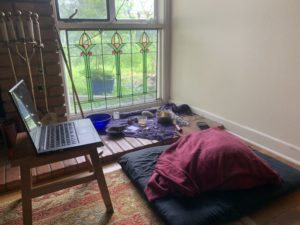 Juniper R’s Home Altar:
Juniper R’s Home Altar:
“The alarm rings at 5:40. I press it once for a ten minute snooze. It takes only five to slip out of bed, dress in something dark and arrived at my cushion logged into the zoom zendo. I light a candle and illuminate the gentle glow of a multi-colored lamp across the room. On my screen I appear as barely a shadow against the wall.
By kinhin the sky out the window is lighter but still nothing of me is visible on the screen. Off camera, I stretch a leg to relieve the pinch behind my knee. Sometime in the second sit enough light comes through the window in front of me to illuminate my face. When robe chant ends I turn toward the screen and study the names of those who’ve sat with me, grateful for the support of this community.”
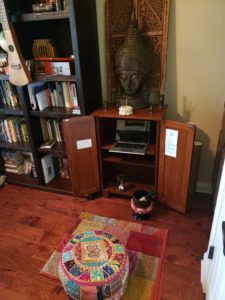 Shu S’s Home Altar:
Shu S’s Home Altar:
Karen L’s Altar:
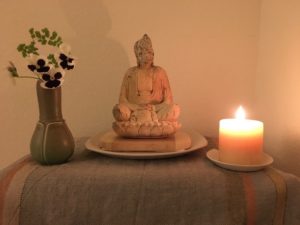 Here is my home altar. The Buddha used to live on my porch at my cabin in California. The porch was above a basement, and then the Thomas Fire in 2017 burned the house, the Buddha fell straight down onto the debris in the basement, landing sitting straight up, but with his head burned. He reminds me of Dogen: “Fearing the swift passage of the sunlight, practice the way as though saving your head from fire.” The vase on the altar is an antique Rookwood ceramic vase that belonged to my stepmother’s family for several generations. The vase survived the Sycamore Canyon Fire in Santa Barbara in 1977. I had stored it at my mother’s apartment in 2017, so it was spared the Thomas Fire. Bows, K
Here is my home altar. The Buddha used to live on my porch at my cabin in California. The porch was above a basement, and then the Thomas Fire in 2017 burned the house, the Buddha fell straight down onto the debris in the basement, landing sitting straight up, but with his head burned. He reminds me of Dogen: “Fearing the swift passage of the sunlight, practice the way as though saving your head from fire.” The vase on the altar is an antique Rookwood ceramic vase that belonged to my stepmother’s family for several generations. The vase survived the Sycamore Canyon Fire in Santa Barbara in 1977. I had stored it at my mother’s apartment in 2017, so it was spared the Thomas Fire. Bows, K
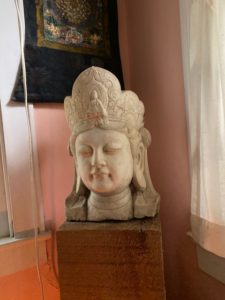 Liliana V’s Altar:
Liliana V’s Altar:
I’m attaching the photo of my home altar. I believe it’s Quan Yin, the Buddha of Compassion. My husband George bought it many years ago while visiting Palo Alto, in an antique shop. He was told it was from a monastery that had closed. We’ve enjoyed it for many years, even before I came to Buddhism. Its always been in our bedroom, and it’s now the centerpiece of my home altar. Its serene beauty radiates all around. And behind it is a Tibetan thangka a friend brought from her travels a long time ago. I don’t know the symbolism behind it, but its intricate drawings are also awe-inspiring. It reminds me of the Buddhist art I was fortunate to see on two occasions at the Rubin Museum in New York City. You can see some of their collections and programs here: htttps://rubinmuseum.org. Thank you for putting this together and for everything the AZC leadership is doing to keep things going during this health crisis. L.
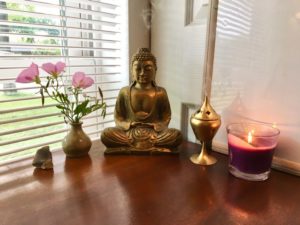 Rich G’s Altar:
Rich G’s Altar:
Here’s my home altar. It sits on my desk. My sister, Michelle A., gave me the Buddha statue for Christmas. I’m reminded of her when I see it. She’s recovering from cancer. I send out loving kindness to her. My routine is to go out and get flowers before zazen. These are Evening Primrose. They’re all over town right now. In a book I read that Evening Primrose symbolize hope and happiness. I really want to contemplate of offer these thoughts and wishes. I’m struggling to have either right now. Somewhere else I read that primroses represent desperation. Perhaps my wish for hope and happiness is desperate in such difficult times. I am trying to let go of wanting things to be otherwise. Zazen helps with that sometimes. When I sit zazen I turn to the door next to my desk. R.
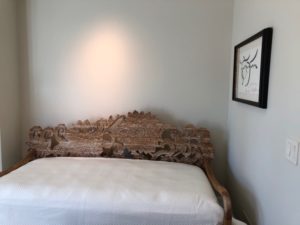
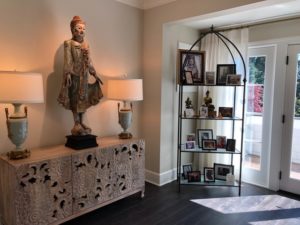 Betty H’s Altar:
Betty H’s Altar:
If you walk down the narrow hallway from my bedroom, you will dead-end at a small, quiet, light-filled space dedicated for meditation. Growing older, I’ve moved from a cushion on the floor to a chair, but I’ve discovered I can still cross my legs and sit upright here on the elevated day bed across from my altar. On beautiful mornings, I may also meditate on the small balcony just adjacent. The large Bodhisattva statue traveled with me from Austin to Whidbey Island, and the lamps on either side belonged to my grandmother. On the shelves I keep photographs of my Tibetan and Zen teachers to bless and inspire my practice. There is a large picture of Guru Rinpoche, as well as statues of the Buddha, Tara and Longchenpa, all important figures in my Nyingma Tibetan lineage. I have a card with the question, “What is my heart’s inmost request right now?” that was a gift from Kosho, and another from Seirin Barbara Kohn with one of Kim Mosley’s remarkable drawings and a quote from Suzuki Roshi. On the wall beside the daybed is a calligraphy from the 12th Gyalwang Drukpa, one of my teachers, and another just out of sight by Kaz Tanahashi. As I sit in this pllace of beauty and peace, I am reminded that we do not practice by or for ourselves. We awaken together. B
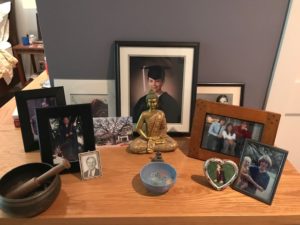 Jack H’s altar:
Jack H’s altar:
offered without comment
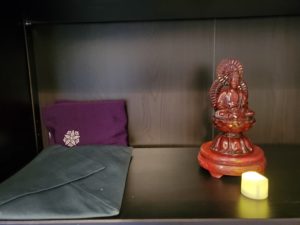 Tracy C’s altar:
Tracy C’s altar:
Little by little our south Austin Home has become one of my main practice centers, with many opportunities to live into Samantabhadra’s vow of respectfully bowing to all Buddhas (Noble Samantabhadra’s Conduct and Vows from the Avatamsaka Sutra [Flower Ornament Scripture], Chapter 39: Arya-Bhadra-Charya-Pandodhana-Raja). Bowing and offering opportunities begin under the front yard bushes where a volcanic stone Jizo-san from Indonesia resides to look over all creatures killed when I mow the grass. Next to the front door is a concrete Buddha from Hempstead, Texas to welcome passersby. In the alcove in the entryway is a wooden Buddha from Cambodia that my brother gave me. To the right in the living room on the bookshelf is a small cabinet housing a calligraphy scroll by Nichiren Daishonin with the title of the Lotus Sutra on it. My wife chants (and me too sometimes) Namu Myoho Renge Kyo there. Then on the table where we eat and talk sits a snow globe Buddha where Shakyamuni sits still as ever, knowing the knowing of the sparkles of worry, joys, stresses, distractions and other Great Matters. Finally, reaching the master bedroom, on a bookshelf given me by my wife, sits my official spartan altar, which has had an incense bowl and flowers, but presently only has my rakusu, lineage document in the purple cloth wrap from Eiheiji, an electric candle, and the cherished Shakyamuni statue given me by Kokyo. He performed an eye-opening ceremony with invisible (just to people with only 2 eyes open) ink on the Buddha. She/he was originally a gift from Kokyo’s mother Jane to Kokyo that he thinks she bought for him from the Tassajara bookstore, and is maybe from Shasta Abbey. I sit every day, wherever it is quiet, which in our small home is a corner of one or the other of my two daughters’ bedrooms. Between sessions, I try to rest in that same still space
 Todd C’s Altar:
Todd C’s Altar:
Traveling through Nepal near the Buddha’s birthplace, I had this wood carving of the Buddha made for me. It also happened to be the celebration oof his birthday at the time. I was so clueless, I was truly caught off guard by how noisy and jubilant everything suddenly became. I had just showed up, wanting a quiet place to meditate. I placed the carving in one of those ubiquitous tin transport-boxes of the Himalayas, strapped it to my back and hiked back down…Two weeks later I was still hiking with it strapped to my back when I finally was able to ship it home. For 30+ years, with every move since (and there have been MANY a quick getaway since), I have only trusted myself to handle it with the right care. Movers and friends just wonder what’s up with this elaborate wrapping and bundling and strapping as the last act of leaving a place. It’s sort of like us watching the ordained unfold and lay out their robes as the bells are ringing, and we are waiting to bow. So, now it’s getting time to get ready to move again. The present lease is running out. I have spent a lot of time in front of this Buddha wondering if we’re going to be stuck sheltering together. Or if we will have a short reprieve so I can once again feel the comforting weight strapped to my back; but this time don a face mask and make a run for it!
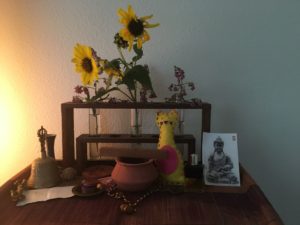 David P’s Altar:
David P’s Altar:
My altar, like my mind, is busy. The cat was sewn by my niece; the radrarushka mala was a gift from my wife’s family, the chips in front are sobriety chips from AA, and the Tibetan bell and vajra relate to my father’s recent passing. The Buddhas was from an AZC mailing 5 or 6 years ago.
Assorted Altars:
